The Impact of Workforce Diversity on Disney's Success
VerifiedAdded on 2020/03/04
|6
|1364
|108
Report
AI Summary
This report analyzes workforce diversity at The Walt Disney Company, examining how Disney has incorporated and maintained a diverse workforce. The report explores various aspects of Disney's diversity initiatives, including employee demographics, gender representation, and the implementation of programs like the Global Workplace and Women Initiative (GWWI). It discusses the benefits of workforce diversity, such as a positive public image and increased talent acquisition, and categorizes different dimensions of diversity. Furthermore, the report highlights Disney's strategies for maintaining a diverse workforce, such as the culture of acceptance approach, and how these strategies have contributed to its success and positive reputation. The analysis includes references to academic sources and company reports to support the findings.
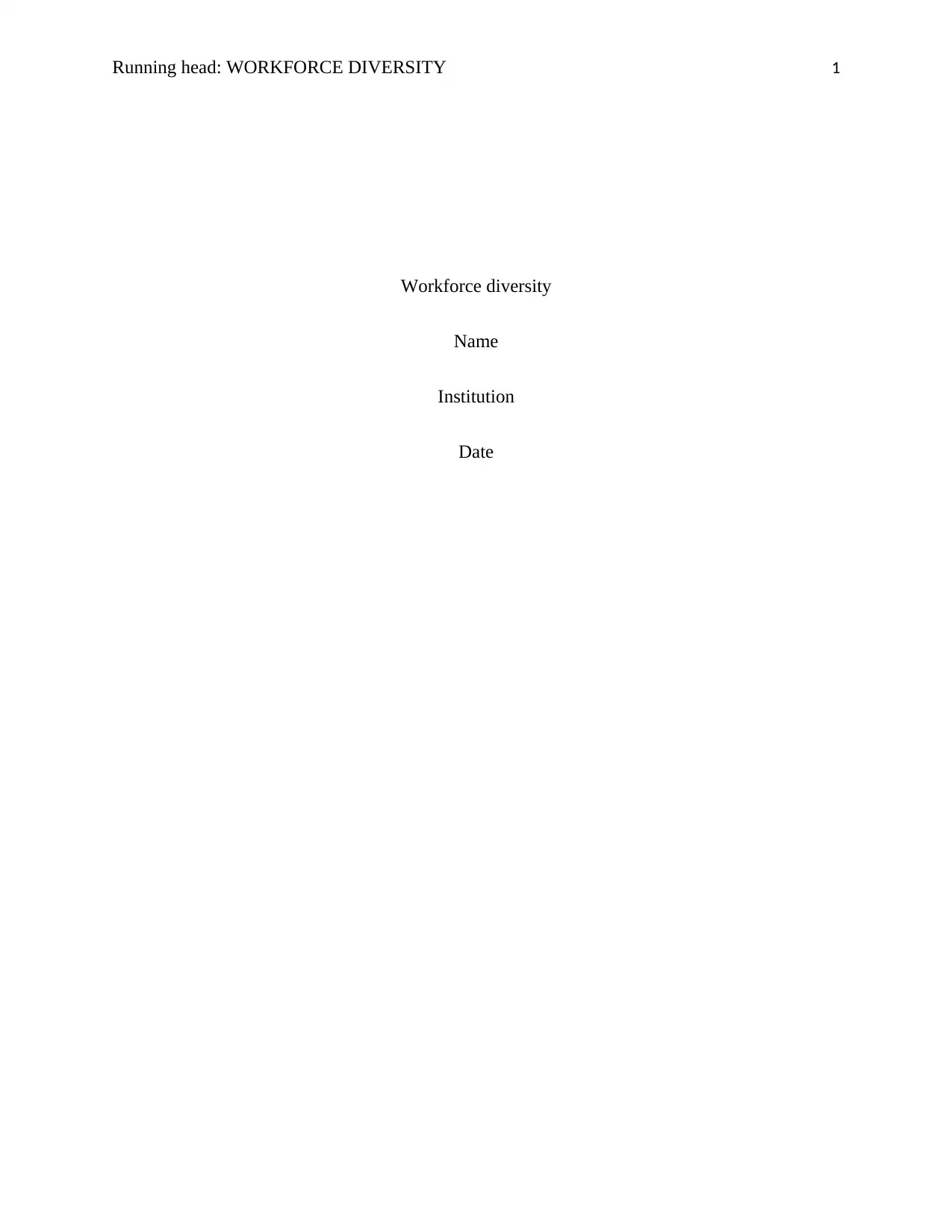
Running head: WORKFORCE DIVERSITY 1
Workforce diversity
Name
Institution
Date
Workforce diversity
Name
Institution
Date
Paraphrase This Document
Need a fresh take? Get an instant paraphrase of this document with our AI Paraphraser
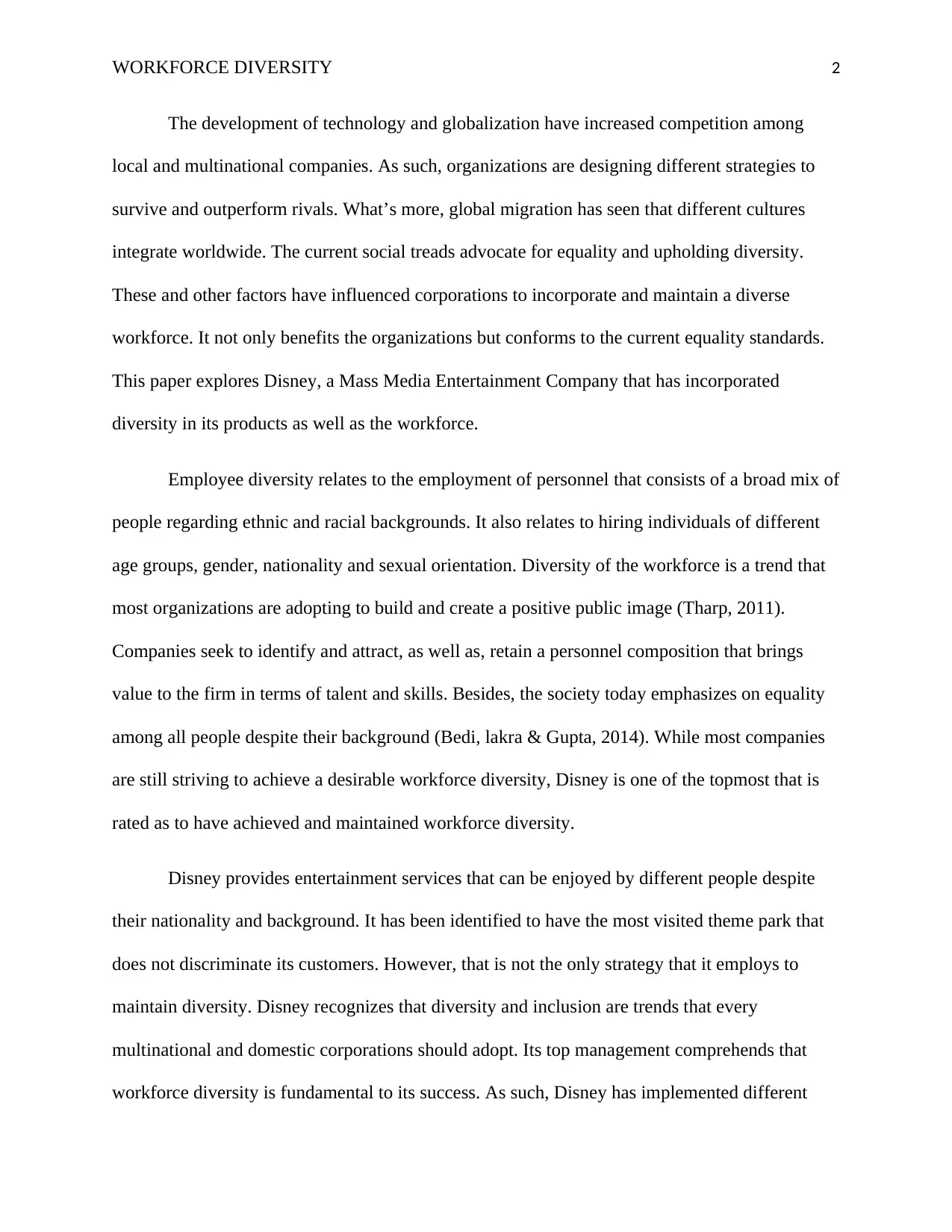
WORKFORCE DIVERSITY 2
The development of technology and globalization have increased competition among
local and multinational companies. As such, organizations are designing different strategies to
survive and outperform rivals. What’s more, global migration has seen that different cultures
integrate worldwide. The current social treads advocate for equality and upholding diversity.
These and other factors have influenced corporations to incorporate and maintain a diverse
workforce. It not only benefits the organizations but conforms to the current equality standards.
This paper explores Disney, a Mass Media Entertainment Company that has incorporated
diversity in its products as well as the workforce.
Employee diversity relates to the employment of personnel that consists of a broad mix of
people regarding ethnic and racial backgrounds. It also relates to hiring individuals of different
age groups, gender, nationality and sexual orientation. Diversity of the workforce is a trend that
most organizations are adopting to build and create a positive public image (Tharp, 2011).
Companies seek to identify and attract, as well as, retain a personnel composition that brings
value to the firm in terms of talent and skills. Besides, the society today emphasizes on equality
among all people despite their background (Bedi, lakra & Gupta, 2014). While most companies
are still striving to achieve a desirable workforce diversity, Disney is one of the topmost that is
rated as to have achieved and maintained workforce diversity.
Disney provides entertainment services that can be enjoyed by different people despite
their nationality and background. It has been identified to have the most visited theme park that
does not discriminate its customers. However, that is not the only strategy that it employs to
maintain diversity. Disney recognizes that diversity and inclusion are trends that every
multinational and domestic corporations should adopt. Its top management comprehends that
workforce diversity is fundamental to its success. As such, Disney has implemented different
The development of technology and globalization have increased competition among
local and multinational companies. As such, organizations are designing different strategies to
survive and outperform rivals. What’s more, global migration has seen that different cultures
integrate worldwide. The current social treads advocate for equality and upholding diversity.
These and other factors have influenced corporations to incorporate and maintain a diverse
workforce. It not only benefits the organizations but conforms to the current equality standards.
This paper explores Disney, a Mass Media Entertainment Company that has incorporated
diversity in its products as well as the workforce.
Employee diversity relates to the employment of personnel that consists of a broad mix of
people regarding ethnic and racial backgrounds. It also relates to hiring individuals of different
age groups, gender, nationality and sexual orientation. Diversity of the workforce is a trend that
most organizations are adopting to build and create a positive public image (Tharp, 2011).
Companies seek to identify and attract, as well as, retain a personnel composition that brings
value to the firm in terms of talent and skills. Besides, the society today emphasizes on equality
among all people despite their background (Bedi, lakra & Gupta, 2014). While most companies
are still striving to achieve a desirable workforce diversity, Disney is one of the topmost that is
rated as to have achieved and maintained workforce diversity.
Disney provides entertainment services that can be enjoyed by different people despite
their nationality and background. It has been identified to have the most visited theme park that
does not discriminate its customers. However, that is not the only strategy that it employs to
maintain diversity. Disney recognizes that diversity and inclusion are trends that every
multinational and domestic corporations should adopt. Its top management comprehends that
workforce diversity is fundamental to its success. As such, Disney has implemented different
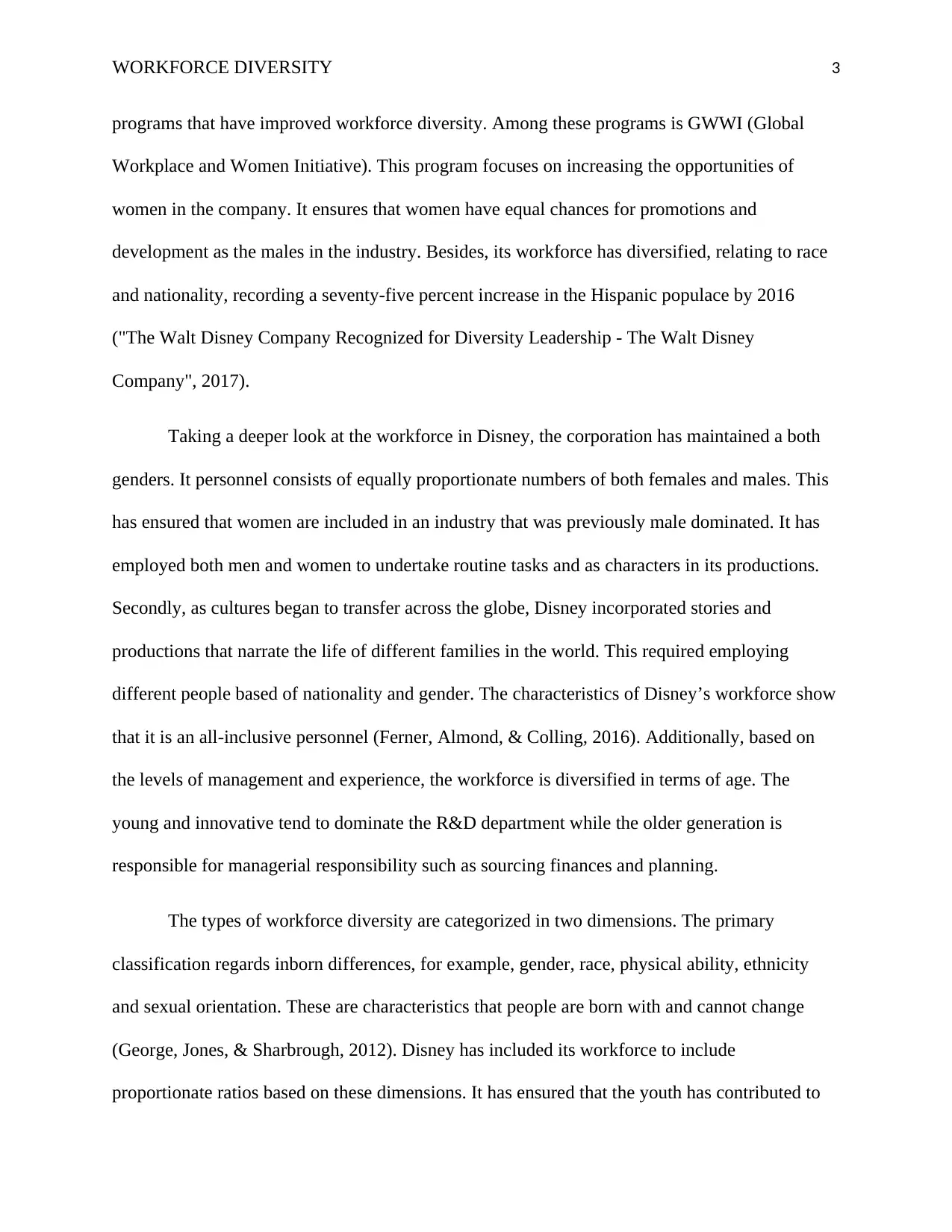
WORKFORCE DIVERSITY 3
programs that have improved workforce diversity. Among these programs is GWWI (Global
Workplace and Women Initiative). This program focuses on increasing the opportunities of
women in the company. It ensures that women have equal chances for promotions and
development as the males in the industry. Besides, its workforce has diversified, relating to race
and nationality, recording a seventy-five percent increase in the Hispanic populace by 2016
("The Walt Disney Company Recognized for Diversity Leadership - The Walt Disney
Company", 2017).
Taking a deeper look at the workforce in Disney, the corporation has maintained a both
genders. It personnel consists of equally proportionate numbers of both females and males. This
has ensured that women are included in an industry that was previously male dominated. It has
employed both men and women to undertake routine tasks and as characters in its productions.
Secondly, as cultures began to transfer across the globe, Disney incorporated stories and
productions that narrate the life of different families in the world. This required employing
different people based of nationality and gender. The characteristics of Disney’s workforce show
that it is an all-inclusive personnel (Ferner, Almond, & Colling, 2016). Additionally, based on
the levels of management and experience, the workforce is diversified in terms of age. The
young and innovative tend to dominate the R&D department while the older generation is
responsible for managerial responsibility such as sourcing finances and planning.
The types of workforce diversity are categorized in two dimensions. The primary
classification regards inborn differences, for example, gender, race, physical ability, ethnicity
and sexual orientation. These are characteristics that people are born with and cannot change
(George, Jones, & Sharbrough, 2012). Disney has included its workforce to include
proportionate ratios based on these dimensions. It has ensured that the youth has contributed to
programs that have improved workforce diversity. Among these programs is GWWI (Global
Workplace and Women Initiative). This program focuses on increasing the opportunities of
women in the company. It ensures that women have equal chances for promotions and
development as the males in the industry. Besides, its workforce has diversified, relating to race
and nationality, recording a seventy-five percent increase in the Hispanic populace by 2016
("The Walt Disney Company Recognized for Diversity Leadership - The Walt Disney
Company", 2017).
Taking a deeper look at the workforce in Disney, the corporation has maintained a both
genders. It personnel consists of equally proportionate numbers of both females and males. This
has ensured that women are included in an industry that was previously male dominated. It has
employed both men and women to undertake routine tasks and as characters in its productions.
Secondly, as cultures began to transfer across the globe, Disney incorporated stories and
productions that narrate the life of different families in the world. This required employing
different people based of nationality and gender. The characteristics of Disney’s workforce show
that it is an all-inclusive personnel (Ferner, Almond, & Colling, 2016). Additionally, based on
the levels of management and experience, the workforce is diversified in terms of age. The
young and innovative tend to dominate the R&D department while the older generation is
responsible for managerial responsibility such as sourcing finances and planning.
The types of workforce diversity are categorized in two dimensions. The primary
classification regards inborn differences, for example, gender, race, physical ability, ethnicity
and sexual orientation. These are characteristics that people are born with and cannot change
(George, Jones, & Sharbrough, 2012). Disney has included its workforce to include
proportionate ratios based on these dimensions. It has ensured that the youth has contributed to
⊘ This is a preview!⊘
Do you want full access?
Subscribe today to unlock all pages.

Trusted by 1+ million students worldwide
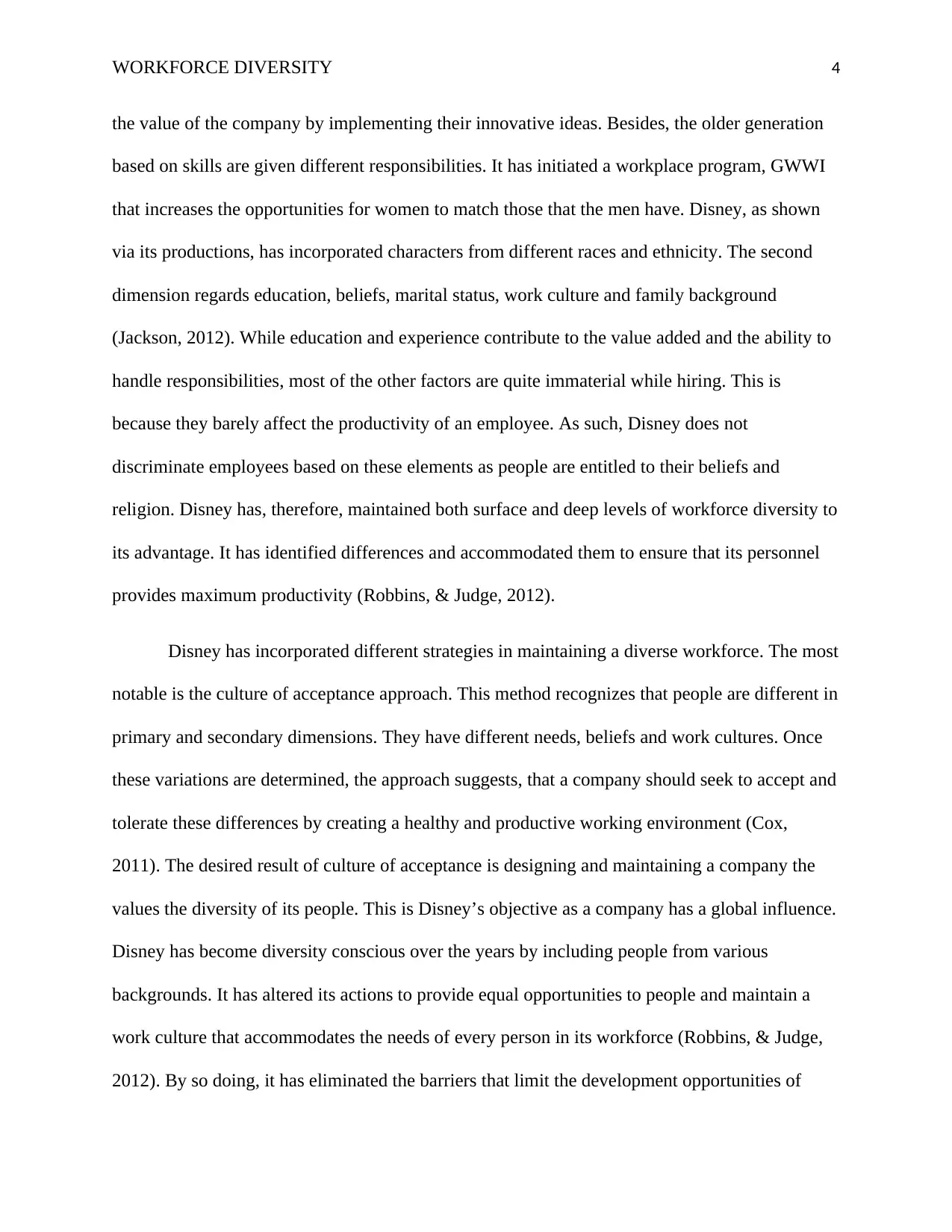
WORKFORCE DIVERSITY 4
the value of the company by implementing their innovative ideas. Besides, the older generation
based on skills are given different responsibilities. It has initiated a workplace program, GWWI
that increases the opportunities for women to match those that the men have. Disney, as shown
via its productions, has incorporated characters from different races and ethnicity. The second
dimension regards education, beliefs, marital status, work culture and family background
(Jackson, 2012). While education and experience contribute to the value added and the ability to
handle responsibilities, most of the other factors are quite immaterial while hiring. This is
because they barely affect the productivity of an employee. As such, Disney does not
discriminate employees based on these elements as people are entitled to their beliefs and
religion. Disney has, therefore, maintained both surface and deep levels of workforce diversity to
its advantage. It has identified differences and accommodated them to ensure that its personnel
provides maximum productivity (Robbins, & Judge, 2012).
Disney has incorporated different strategies in maintaining a diverse workforce. The most
notable is the culture of acceptance approach. This method recognizes that people are different in
primary and secondary dimensions. They have different needs, beliefs and work cultures. Once
these variations are determined, the approach suggests, that a company should seek to accept and
tolerate these differences by creating a healthy and productive working environment (Cox,
2011). The desired result of culture of acceptance is designing and maintaining a company the
values the diversity of its people. This is Disney’s objective as a company has a global influence.
Disney has become diversity conscious over the years by including people from various
backgrounds. It has altered its actions to provide equal opportunities to people and maintain a
work culture that accommodates the needs of every person in its workforce (Robbins, & Judge,
2012). By so doing, it has eliminated the barriers that limit the development opportunities of
the value of the company by implementing their innovative ideas. Besides, the older generation
based on skills are given different responsibilities. It has initiated a workplace program, GWWI
that increases the opportunities for women to match those that the men have. Disney, as shown
via its productions, has incorporated characters from different races and ethnicity. The second
dimension regards education, beliefs, marital status, work culture and family background
(Jackson, 2012). While education and experience contribute to the value added and the ability to
handle responsibilities, most of the other factors are quite immaterial while hiring. This is
because they barely affect the productivity of an employee. As such, Disney does not
discriminate employees based on these elements as people are entitled to their beliefs and
religion. Disney has, therefore, maintained both surface and deep levels of workforce diversity to
its advantage. It has identified differences and accommodated them to ensure that its personnel
provides maximum productivity (Robbins, & Judge, 2012).
Disney has incorporated different strategies in maintaining a diverse workforce. The most
notable is the culture of acceptance approach. This method recognizes that people are different in
primary and secondary dimensions. They have different needs, beliefs and work cultures. Once
these variations are determined, the approach suggests, that a company should seek to accept and
tolerate these differences by creating a healthy and productive working environment (Cox,
2011). The desired result of culture of acceptance is designing and maintaining a company the
values the diversity of its people. This is Disney’s objective as a company has a global influence.
Disney has become diversity conscious over the years by including people from various
backgrounds. It has altered its actions to provide equal opportunities to people and maintain a
work culture that accommodates the needs of every person in its workforce (Robbins, & Judge,
2012). By so doing, it has eliminated the barriers that limit the development opportunities of
Paraphrase This Document
Need a fresh take? Get an instant paraphrase of this document with our AI Paraphraser
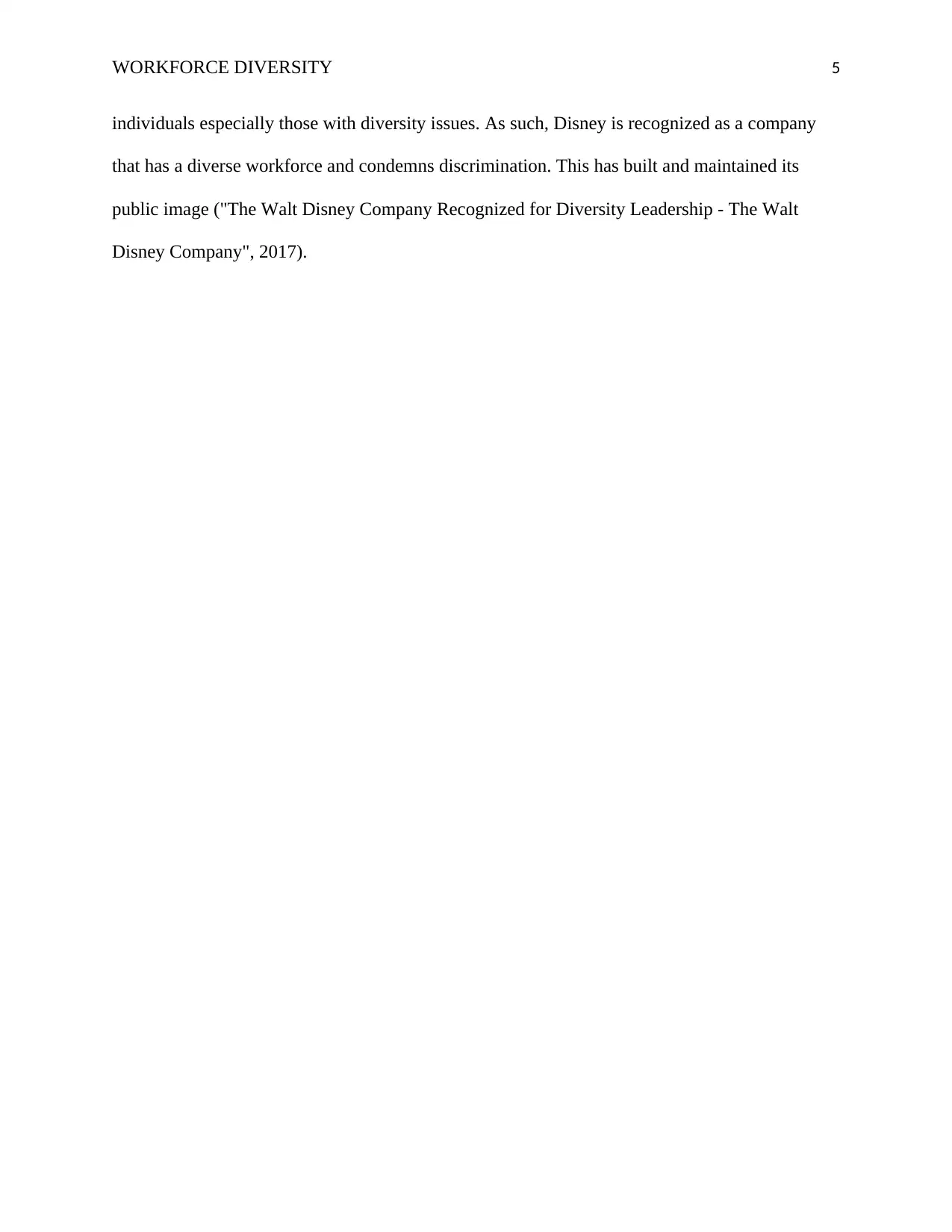
WORKFORCE DIVERSITY 5
individuals especially those with diversity issues. As such, Disney is recognized as a company
that has a diverse workforce and condemns discrimination. This has built and maintained its
public image ("The Walt Disney Company Recognized for Diversity Leadership - The Walt
Disney Company", 2017).
individuals especially those with diversity issues. As such, Disney is recognized as a company
that has a diverse workforce and condemns discrimination. This has built and maintained its
public image ("The Walt Disney Company Recognized for Diversity Leadership - The Walt
Disney Company", 2017).
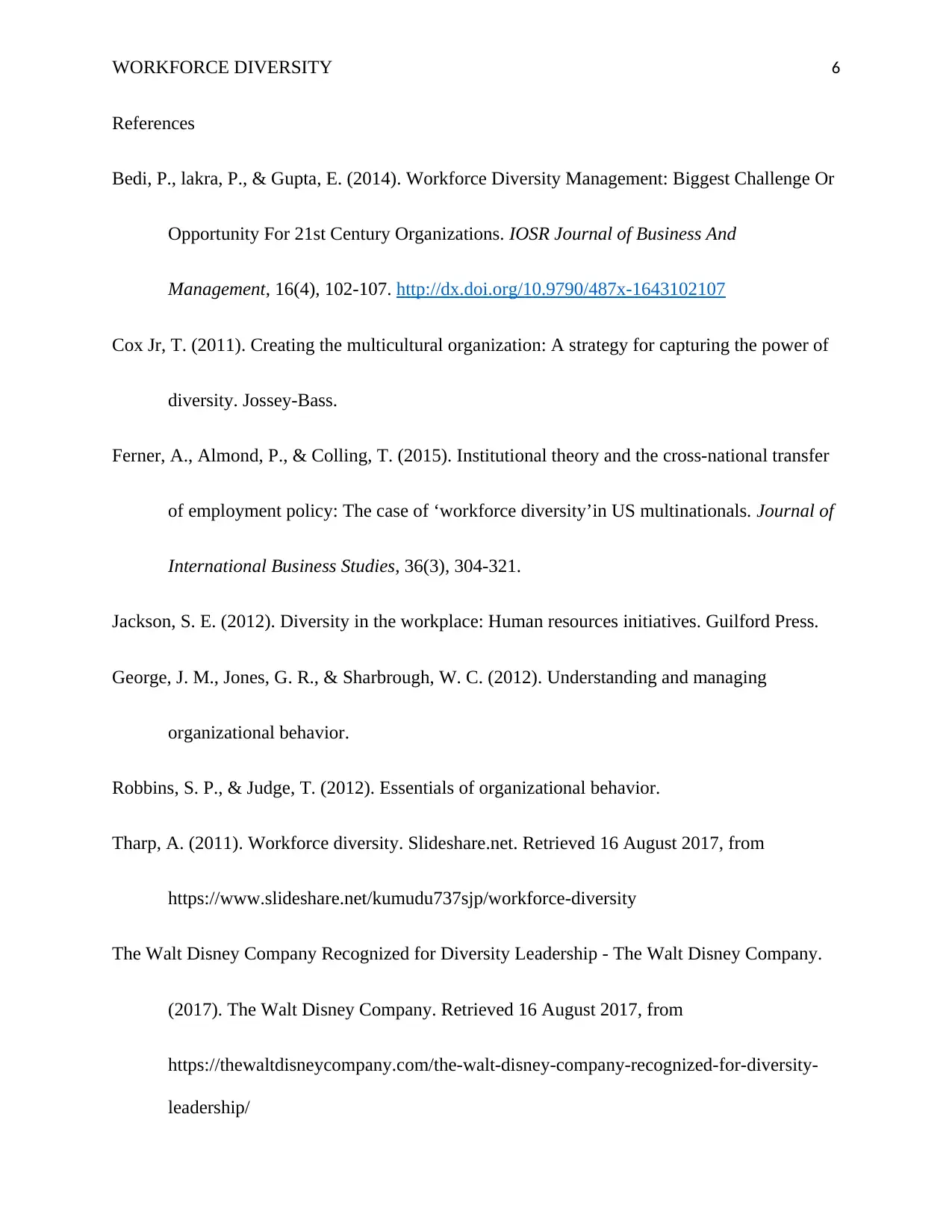
WORKFORCE DIVERSITY 6
References
Bedi, P., lakra, P., & Gupta, E. (2014). Workforce Diversity Management: Biggest Challenge Or
Opportunity For 21st Century Organizations. IOSR Journal of Business And
Management, 16(4), 102-107. http://dx.doi.org/10.9790/487x-1643102107
Cox Jr, T. (2011). Creating the multicultural organization: A strategy for capturing the power of
diversity. Jossey-Bass.
Ferner, A., Almond, P., & Colling, T. (2015). Institutional theory and the cross-national transfer
of employment policy: The case of ‘workforce diversity’in US multinationals. Journal of
International Business Studies, 36(3), 304-321.
Jackson, S. E. (2012). Diversity in the workplace: Human resources initiatives. Guilford Press.
George, J. M., Jones, G. R., & Sharbrough, W. C. (2012). Understanding and managing
organizational behavior.
Robbins, S. P., & Judge, T. (2012). Essentials of organizational behavior.
Tharp, A. (2011). Workforce diversity. Slideshare.net. Retrieved 16 August 2017, from
https://www.slideshare.net/kumudu737sjp/workforce-diversity
The Walt Disney Company Recognized for Diversity Leadership - The Walt Disney Company.
(2017). The Walt Disney Company. Retrieved 16 August 2017, from
https://thewaltdisneycompany.com/the-walt-disney-company-recognized-for-diversity-
leadership/
References
Bedi, P., lakra, P., & Gupta, E. (2014). Workforce Diversity Management: Biggest Challenge Or
Opportunity For 21st Century Organizations. IOSR Journal of Business And
Management, 16(4), 102-107. http://dx.doi.org/10.9790/487x-1643102107
Cox Jr, T. (2011). Creating the multicultural organization: A strategy for capturing the power of
diversity. Jossey-Bass.
Ferner, A., Almond, P., & Colling, T. (2015). Institutional theory and the cross-national transfer
of employment policy: The case of ‘workforce diversity’in US multinationals. Journal of
International Business Studies, 36(3), 304-321.
Jackson, S. E. (2012). Diversity in the workplace: Human resources initiatives. Guilford Press.
George, J. M., Jones, G. R., & Sharbrough, W. C. (2012). Understanding and managing
organizational behavior.
Robbins, S. P., & Judge, T. (2012). Essentials of organizational behavior.
Tharp, A. (2011). Workforce diversity. Slideshare.net. Retrieved 16 August 2017, from
https://www.slideshare.net/kumudu737sjp/workforce-diversity
The Walt Disney Company Recognized for Diversity Leadership - The Walt Disney Company.
(2017). The Walt Disney Company. Retrieved 16 August 2017, from
https://thewaltdisneycompany.com/the-walt-disney-company-recognized-for-diversity-
leadership/
⊘ This is a preview!⊘
Do you want full access?
Subscribe today to unlock all pages.

Trusted by 1+ million students worldwide
1 out of 6
Related Documents
Your All-in-One AI-Powered Toolkit for Academic Success.
+13062052269
info@desklib.com
Available 24*7 on WhatsApp / Email
![[object Object]](/_next/static/media/star-bottom.7253800d.svg)
Unlock your academic potential
Copyright © 2020–2025 A2Z Services. All Rights Reserved. Developed and managed by ZUCOL.





